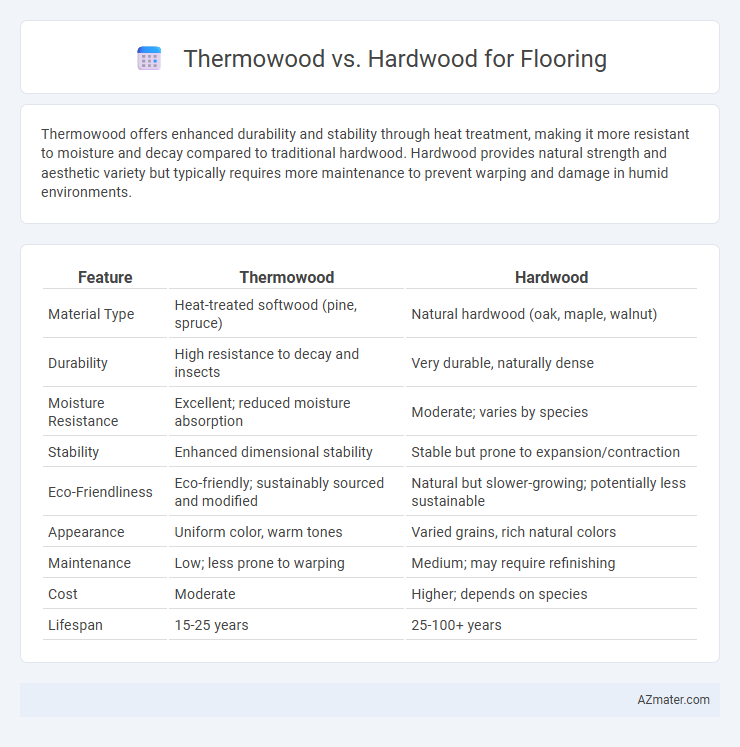Thermowood offers enhanced durability and stability through heat treatment, making it more resistant to moisture and decay compared to traditional hardwood. Hardwood provides natural strength and aesthetic variety but typically requires more maintenance to prevent warping and damage in humid environments.
Table of Comparison
| Feature | Thermowood | Hardwood |
|---|---|---|
| Material Type | Heat-treated softwood (pine, spruce) | Natural hardwood (oak, maple, walnut) |
| Durability | High resistance to decay and insects | Very durable, naturally dense |
| Moisture Resistance | Excellent; reduced moisture absorption | Moderate; varies by species |
| Stability | Enhanced dimensional stability | Stable but prone to expansion/contraction |
| Eco-Friendliness | Eco-friendly; sustainably sourced and modified | Natural but slower-growing; potentially less sustainable |
| Appearance | Uniform color, warm tones | Varied grains, rich natural colors |
| Maintenance | Low; less prone to warping | Medium; may require refinishing |
| Cost | Moderate | Higher; depends on species |
| Lifespan | 15-25 years | 25-100+ years |
Introduction to Thermowood and Hardwood Flooring
Thermowood flooring, made by heat-treating softwood like pine or spruce at high temperatures, offers enhanced durability, dimensional stability, and resistance to decay compared to untreated wood. Hardwood flooring, derived from dense, slow-growing trees such as oak, maple, or walnut, is prized for its natural strength, rich grain patterns, and long-lasting wear. Both options present unique benefits: Thermowood emphasizes eco-friendly treatment and moisture resistance, while hardwood delivers classic aesthetics and exceptional hardness for high-traffic areas.
Key Differences Between Thermowood and Hardwood
Thermowood undergoes a controlled heat treatment process that enhances its durability, dimensional stability, and resistance to moisture compared to traditional hardwood. Hardwood, derived from slow-growing deciduous trees, offers natural density, strength, and a classic aesthetic but may require more maintenance in humid environments. Thermowood's enhanced thermal properties and eco-friendly treatment make it a preferred choice for outdoor and moisture-prone flooring, whereas hardwood's natural grain and hardness appeal to indoor applications seeking timeless elegance.
Durability: Thermowood vs Hardwood Flooring
Thermowood flooring offers enhanced durability compared to traditional hardwood due to its heat-treated process, which reduces moisture content and increases resistance to decay, mold, and insect attacks. Hardwood, while naturally strong, can be more susceptible to environmental damage such as warping and swelling in humid conditions, especially species with lower density. The thermal modification of Thermowood improves dimensional stability and longevity, making it a superior choice for flooring in areas with fluctuating climates.
Aesthetic Appeal and Design Options
Thermowood flooring offers a rich, warm tone with enhanced texture, making it ideal for contemporary designs seeking natural yet durable aesthetics. Hardwood floors provide classic, timeless beauty with a wide range of species, grain patterns, and finishes, allowing versatile customization for both traditional and modern interiors. Choosing between Thermowood and hardwood depends on the desired balance between innovative thermal modification benefits and the authentic character of natural wood grains.
Environmental Impact and Sustainability
Thermowood, produced through heat treatment of softwoods like pine or spruce, offers enhanced durability and resistance to decay without chemical additives, making it an eco-friendly alternative to traditional hardwood flooring. Hardwood flooring, sourced from slow-growing trees such as oak or maple, presents concerns related to deforestation and longer regeneration periods, impacting sustainability. Choosing Thermowood supports reduced environmental footprint due to its use of fast-growing species and energy-efficient thermal modification processes.
Installation Process: Thermowood vs Hardwood
Thermowood flooring offers a simplified installation process due to its enhanced dimensional stability and reduced moisture content, which minimizes expansion and contraction issues compared to traditional hardwood. Hardwood flooring installation requires careful acclimatization and moisture control to prevent warping and gaps, often necessitating professional expertise for sanding and finishing on-site. Thermowood's uniform moisture profile allows for more predictable spacing and fastening, reducing installation time and long-term maintenance challenges.
Maintenance and Longevity Comparison
Thermowood flooring offers superior resistance to moisture, decay, and insects compared to traditional hardwoods, resulting in lower maintenance requirements such as less frequent sealing and refinishing. Hardwood floors, while durable, often demand regular polishing, sealing, and can be more prone to warping or damage in humid environments. Thermowood's enhanced dimensional stability ensures a longer lifespan with minimal upkeep, making it an ideal choice for high-traffic or moisture-prone areas.
Cost Analysis: Upfront and Long-Term Expenses
Thermowood flooring typically has a higher upfront cost compared to traditional hardwood due to the added thermally modified process, which enhances durability and stability. Over the long term, Thermowood offers reduced maintenance expenses and increased resistance to moisture and decay, potentially lowering replacement and repair costs. Hardwood flooring may require more frequent refinishing and treatment, leading to higher cumulative costs despite a lower initial investment.
Suitability for Different Environments and Applications
Thermowood flooring, produced through heat treatment of softwoods, exhibits enhanced durability, dimensional stability, and resistance to moisture, making it ideal for humid or outdoor environments compared to traditional hardwoods like oak or maple. Hardwood flooring offers superior hardness and aesthetic appeal suited for indoor residential and commercial spaces with stable humidity levels. Selecting between Thermowood and hardwood depends on specific environmental conditions, application requirements, and maintenance preferences to ensure longevity and performance.
Conclusion: Which Flooring is Right for You?
Thermowood offers enhanced durability and moisture resistance through heat treatment, making it ideal for humid or outdoor environments, while traditional hardwood delivers natural beauty and a classic aesthetic with a wider range of species and grain patterns. Homeowners prioritizing eco-friendliness and low maintenance often prefer Thermowood, whereas those seeking timeless elegance and potential for refinishing tend to choose hardwood flooring. The decision ultimately depends on your specific needs, budget, and environmental conditions influencing the longevity and appearance of your floors.

Infographic: Thermowood vs Hardwood for Flooring
 azmater.com
azmater.com